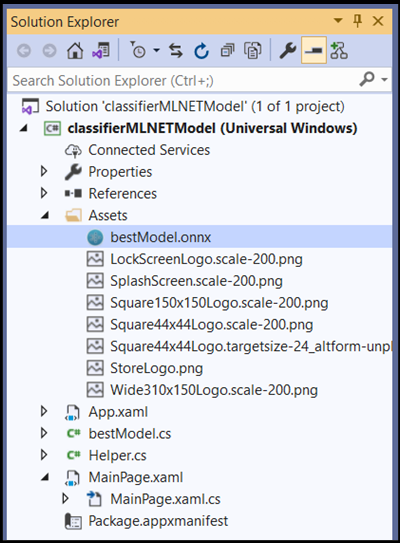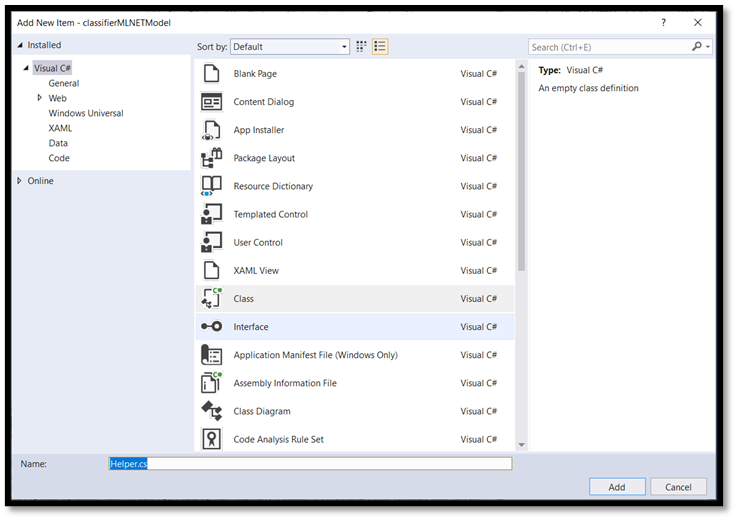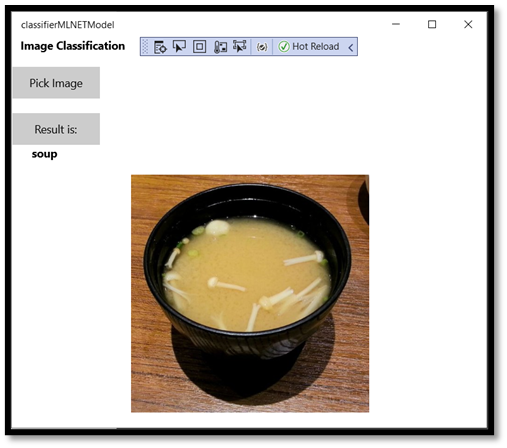Deploy your ML.NET model in a Windows app with the Windows Machine Learning APIs
In the previous part of this tutorial, you learned how to build and export a ML.NET model in ONNX format. Now that you have that model, you can embed it into a Windows application and run it locally on a device by calling WinML APIs.
Once we're done, you'll have a working Image classifier WinML UWP app (C#).
About the sample app
Using our model, we'll create an app that can classify images of food. It allows you to select an image from your local device and process it by a locally stored classification ONNX model you built and trained in the previous part. The tags returned are displayed next to the image, as well as the the confidence probability of the classification.
If you've been following this tutorial so far, you should already have the necessary prerequisites for app development in place. If you need a refresher, see the first part of this tutorial.
Note
If you prefer to download the complete sample code, you can clone the solution file. Clone the repository, navigate to this sample, then open the classifierMLNETModel.sln file with Visual Studio. Then, you can skip to the [Launch the application](#Launch the application) step.
Create a WinML UWP (C#)
Below, we'll show you how to create your app and WinML code from scratch. You'll learn how to:
- Load a machine learning model.
- Load an image in the required format.
- Bind the model's inputs and outputs.
- Evaluate the model and display meaningful results.
You'll also use basic XAML to create a simple GUI, so you can test the image classifier.
Create the app
- Open Visual Studio and choose
create a new project.

- In the search bar, type
UWPand then selectBlank APP (Universal Windows). This opens a new C# project for a single-page Universal Windows Platform (UWP) app that has no predefined controls or layout. SelectNextto open a configuration window for the project.

- In the configuration window:
- Choose a name for your project. Here, we use classifierMLNETModel.
- Choose the location of your project.
- If you're using VS 2019, ensure
Place solution and project in the same directoryis unchecked. - If you're using VS 2017, ensure
Create directory for solutionis checked.

Press create to create your project. The minimum target version window may pop up. Be sure your minimum version is set to Windows 10 build 17763 or later.
To create an app and deploy a model with a WinML app, you'll need the following:
- After the project was created, navigate to the project folder, open the assets folder [….\classifierMLNETModel\Assets], and copy your
bestModel.onnxfile to this location.
Explore project solution
Let's explore your project solution.
Visual Studio automatically created several cs-code files inside the Solution Explorer. MainPage.xaml contains the XAML code for your GUI, and MainPage.xaml.cs contains your application code. If you've created a UWP app before, these files should be very familiar to you.
Create the Application GUI
First, let's create a simple GUI for your app.
Double-click on the
MainPage.xamlfile. In your blank app, the XAML template for your app's GUI is empty, so we'll need to add some UI features.Replace the code of
MainPage.xamlwith the following.
<Page
x:Class="classifierMLNETModel.MainPage"
xmlns="http://schemas.microsoft.com/winfx/2006/xaml/presentation"
xmlns:x="http://schemas.microsoft.com/winfx/2006/xaml"
xmlns:local="using:classifierMLNETModel"
xmlns:d="http://schemas.microsoft.com/expression/blend/2008"
xmlns:mc="http://schemas.openxmlformats.org/markup-compatibility/2006"
mc:Ignorable="d"
Background="{ThemeResource ApplicationPageBackgroundThemeBrush}">
<Grid Background="{ThemeResource ApplicationPageBackgroundThemeBrush}">
<StackPanel Margin="1,0,-1,0">
<TextBlock x:Name="Menu"
FontWeight="Bold"
TextWrapping="Wrap"
Margin="10,0,0,0"
Text="Image Classification"/>
<TextBlock Name="space" />
<Button Name="recognizeButton"
Content="Pick Image"
Click="OpenFileButton_Click"
Width="110"
Height="40"
IsEnabled="True"
HorizontalAlignment="Left"/>
<TextBlock Name="space3" />
<Button Name="Output"
Content="Result is:"
Width="110"
Height="40"
IsEnabled="True"
HorizontalAlignment="Left"
VerticalAlignment="Top">
</Button>
<!--Dispaly the Result-->
<TextBlock Name="displayOutput"
FontWeight="Bold"
TextWrapping="Wrap"
Margin="25,0,0,0"
Text="" Width="1471" />
<TextBlock Name="space2" />
<!--Image preview -->
<Image Name="UIPreviewImage" Stretch="Uniform" MaxWidth="300" MaxHeight="300"/>
</StackPanel>
</Grid>
</Page>
Add the model to the project using Windows Machine Learning Code Generator
Windows Machine Learning Code Generator, or mlgen, is a Visual Studio extension to help you get started using WinML APIs on UWP apps. It generates template code when you add a trained ONNX file into the UWP project.
Windows Machine Learning's code generator mlgen creates an interface (for C#, C++/WinRT, and C++/CX) with wrapper classes that call the Windows ML API for you. This allows you to easily load, bind, and evaluate a model in your project. We'll use it in this tutorial to handle many of those functions for us.
Code generator is available for Visual Studio 2017 and later. Please be aware that in Windows 10, version 1903 and later, mlgen is no longer included in the Windows 10 SDK, so you must download and install the extension. If you've been following this tutorial from the introduction, you will have already handled this, but if not, you should download for VS 2019 or for VS 2017.
Note
To learn more about mlgen, please see the mlgen documentation
If you haven't already, install mlgen.
Right-click on the
Assetsfolder in the Solution Explorer in Visual studio, and selectAdd > Existing Item.Navigate to the assets folder inside
ImageClassifierAppUWP [….\ImageClassifierAppUWP\Assets], find the ONNX model you previously copied there, and selectadd.After you added an ONNX model (name: “classifier”) to the assets folder in solution explorer in VS, the project should now have two new files:
bestModel.onnx- this is your model in ONNX format.bestModel.cs– automatically generated WinML code file.

- To make sure the model builds when you compile our application, select the
bestModel.onnxfile and chooseProperties. ForBuild Action, selectContent.
Now, let’s explore the newly generated code in the bestModel.cs file.
The generated code includes three classes:
bestModelModel: This class includes two methods for model instantiation and model evaluation. It will help us to create the machine learning model representation, create a session on the system default device, bind the specific inputs and outputs to the model, and evaluate the model asynchronously.bestModelInput: This class initializes the input types that the model expects. The model input depends on the model requirements for input data.bestModelOutput: This class initializes the types that the model will output. The model output depends on how it is defined by the model.
You'll now use these classes to load, bind, and evaluate the model in our project.
Tensor conversion
To make it easier dealing with tensorization, change the input TensorFloat class to ImageFeatureValue.
- Make the following changes in the
bestModel.csfile:
The code:
public sealed class bestModelInput
{
public TensorFloat input; // shape(-1,3,32,32)
}
Will become:
public sealed class bestModelInput
{
public ImageFeatureValue input; // shape(-1,3,32,32)
}
Load the model & inputs
Load the model
Double-click on the
MainPage.xaml.cscode file to open the application code.Replace the “using” statements with the following, to get an access to all the APIs that you'll need.
// Specify all the using statements which give us the access to all the APIs that you'll need
using System;
using System.Threading.Tasks;
using Windows.AI.MachineLearning;
using Windows.Graphics.Imaging;
using Windows.Media;
using Windows.Storage;
using Windows.Storage.Pickers;
using Windows.Storage.Streams;
using Windows.UI.Xaml;
using Windows.UI.Xaml.Controls;
using Windows.UI.Xaml.Media.Imaging;
- Add the following variable declarations after the using statements inside your
MainPageclass, under the namespaceclassifierMLNETModel.
// All the required fields declaration
private bestModelModel modelGen;
private bestModelInput image = new bestModelInput();
private bestModelOutput results;
private StorageFile selectedStorageFile;
private string label = "";
private float probability = 0;
private Helper helper = new Helper();
public enum Labels
{
desert,
soup,
vegetable_fruit,
}
Now, you'll implement the LoadModel method. The method will access the ONNX model and store it in memory. Then, you'll use the CreateFromStreamAsync method to instantiate the model as a LearningModel object. The LearningModel class represents a trained machine learning model. Once instantiated, the LearningModel is the initial object you use to interact with Windows ML.
To load the model, you can use several static methods in the LearningModel class. In this case, you'll use the CreateFromStreamAsync method.
The CreateFromStreamAsync method was automatically created with mlgen, so you don't need to implement this method. You can review this method by double clicking on the bestModel.cs file generated file by mlgen.
To learn more about LearningModel class, please review the LearningModel Class documentation.
To learn more about additional ways of loading the model, please review the Load a model documentation
- Let’s define the main method.
// The main page to initialize and execute the model.
public MainPage()
{
this.InitializeComponent();
loadModel();
}
- Add the implementation of the
loadModelmethod to yourMainPage.xaml.cscode file inside theMainPageclass.
private async Task loadModel()
{
// Get an access the ONNX model and save it in memory.
StorageFile modelFile = await StorageFile.GetFileFromApplicationUriAsync(new Uri($"ms-appx:///Assets/bestModel.onnx"));
// Instantiate the model.
modelGen = await bestModelModel.CreateFromStreamAsync(modelFile);
}
Load the Image
- We need to define a click event to initiate the sequence of four method calls for model execution – conversion, binding and evaluation, output extraction and display the results. Add the following method to your
MainPage.xaml.cscode file inside theMainPageclass.
// Waiting for a click event to select a file
private async void OpenFileButton_Click(object sender, RoutedEventArgs e)
{
if (!await getImage())
{
return;
}
// After the click event happened and an input selected, begin the model execution.
// Bind the model input
await imageBind();
// Model evaluation
await evaluate();
// Extract the results
extractResult();
// Display the results
await displayResult();
}
- Now, you'll implement the
getImage()method. This method will select an input image file and save it in memory. Add the following method to yourMainPage.xaml.cscode file inside theMainPageclass.
// A method to select an input image file
private async Task<bool> getImage()
{
try
{
// Trigger file picker to select an image file
FileOpenPicker fileOpenPicker = new FileOpenPicker();
fileOpenPicker.SuggestedStartLocation = PickerLocationId.PicturesLibrary;
fileOpenPicker.FileTypeFilter.Add(".jpg");
fileOpenPicker.FileTypeFilter.Add(".png");
fileOpenPicker.ViewMode = PickerViewMode.Thumbnail;
selectedStorageFile = await fileOpenPicker.PickSingleFileAsync();
if (selectedStorageFile == null)
{
return false;
}
}
catch (Exception)
{
return false;
}
return true;
}
Next, you will implement an image Bind() method to get the representation of the file in the bitmap BGRA8 format. But first, you'll create a helper class to resize the image.
- To create a helper file, right-click on the solution name (
ClassifierPyTorch), then chooseAdd a new item. In the open window, selectClassand give it a name. Here, we're calling itHelper.

- A new class file will appear within your project. Open this class, and add the following code:
using System;
using System.Threading.Tasks;
using Windows.Graphics.Imaging;
using Windows.Media;
namespace classifierPyTorch
{
public class Helper
{
private const int SIZE = 32;
VideoFrame cropped_vf = null;
public async Task<VideoFrame> CropAndDisplayInputImageAsync(VideoFrame inputVideoFrame)
{
bool useDX = inputVideoFrame.SoftwareBitmap == null;
BitmapBounds cropBounds = new BitmapBounds();
uint h = SIZE;
uint w = SIZE;
var frameHeight = useDX ? inputVideoFrame.Direct3DSurface.Description.Height : inputVideoFrame.SoftwareBitmap.PixelHeight;
var frameWidth = useDX ? inputVideoFrame.Direct3DSurface.Description.Width : inputVideoFrame.SoftwareBitmap.PixelWidth;
var requiredAR = ((float)SIZE / SIZE);
w = Math.Min((uint)(requiredAR * frameHeight), (uint)frameWidth);
h = Math.Min((uint)(frameWidth / requiredAR), (uint)frameHeight);
cropBounds.X = (uint)((frameWidth - w) / 2);
cropBounds.Y = 0;
cropBounds.Width = w;
cropBounds.Height = h;
cropped_vf = new VideoFrame(BitmapPixelFormat.Bgra8, SIZE, SIZE, BitmapAlphaMode.Ignore);
await inputVideoFrame.CopyToAsync(cropped_vf, cropBounds, null);
return cropped_vf;
}
}
}
Now, let's convert the image to the appropriate format.
The bestModelInput class initializes the input types that the model expects. In our case, we configured our code to expect an ImageFeatureValue.
The ImageFeatureValue class describes the properties of the image used to pass into a model. To create anImageFeatureValue, you use CreateFromVideoFrame method. For more specific details of why this is the case and how these classes and methods work, see the ImageFeatureValue class documentation.
Note
In this tutorial, we use the ImageFeatureValue class instead of a tensor. If Window ML does not support your model’s color format, this won't be an option. For an example of how to work with image conversions and tensorization, see the Custom Tensorization Sample.
- Add the implementation of the
convert()method to yourMainPage.xaml.cscode file inside the MainPage class. The convert method will get us a representation of the input file in a BGRA8 format.
// A method to convert and bind the input image.
private async Task imageBind()
{
UIPreviewImage.Source = null;
try
{
SoftwareBitmap softwareBitmap;
using (IRandomAccessStream stream = await selectedStorageFile.OpenAsync(FileAccessMode.Read))
{
// Create the decoder from the stream
BitmapDecoder decoder = await BitmapDecoder.CreateAsync(stream);
// Get the SoftwareBitmap representation of the file in BGRA8 format
softwareBitmap = await decoder.GetSoftwareBitmapAsync();
softwareBitmap = SoftwareBitmap.Convert(softwareBitmap, BitmapPixelFormat.Bgra8, BitmapAlphaMode.Premultiplied);
}
// Display the image
SoftwareBitmapSource imageSource = new SoftwareBitmapSource();
await imageSource.SetBitmapAsync(softwareBitmap);
UIPreviewImage.Source = imageSource;
// Encapsulate the image within a VideoFrame to be bound and evaluated
VideoFrame inputImage = VideoFrame.CreateWithSoftwareBitmap(softwareBitmap);
// Resize the image size to 224x224
inputImage=await helper.CropAndDisplayInputImageAsync(inputImage);
// Bind the model input with image
ImageFeatureValue imageTensor = ImageFeatureValue.CreateFromVideoFrame(inputImage);
image.input1 = imageTensor;
// Encapsulate the image within a VideoFrame to be bound and evaluated
VideoFrame inputImage = VideoFrame.CreateWithSoftwareBitmap(softwareBitmap);
// Bind the input image
ImageFeatureValue imageTensor = ImageFeatureValue.CreateFromVideoFrame(inputImage);
image.modelInput = imageTensor;
}
catch (Exception e)
{
}
}
Bind and Evaluate the model
Next, you'll create a session based on the model, bind the input and output from the session, and evaluate the model.
Create a session to bind the model:
To create a session, you use the LearningModelSession class. This class is used to evaluate machine learning models, and binds the model to a device that then runs and evaluates the model. You can select a device when you create a session to execute your model on a specific device of your machine. The default device is the CPU.
Note
To learn more about how to choose a device, please review the Create a session documentation.
Bind model inputs and outputs:
To bind input and output, you use the LearningModelBinding class. A machine learning model has input and output features, which pass information into and out of the model. Be aware that required features must be supported by the Window ML APIs. The LearningModelBinding class is applied on a LearningModelSession to bind values to named input and output features.
The implementation of the binding is automatically generated by mlgen, so you don’t have to take care of it. The binding is implemented by calling the predefined methods of the LearningModelBinding class. In our case, it uses the Bind method to bind a value to the named feature type.
Evaluate the model:
After you create a session to bind the model and bounded values to a model’s inputs and outputs, you can evaluate the model’s inputs and get its predictions. To run the model execution, you should call any of the predefined evaluate methods on the LearningModelSession. In our case, we'll use the EvaluateAsync method.
Similar to CreateFromStreamAsync, the EvaluateAsync method was also automatically generated by WinML Code Generator, so you don’t need to implement this method. You can review this method in the bestModel.cs file.
The EvaluateAsync method will asynchronously evaluate the machine learning model using the feature values already bound in bindings. It will create a session with LearningModelSession, bind the input and output with LearningModelBinding, execute the model evaluation, and get the output features of the model using the LearningModelEvaluationResult class.
Note
To learn about other evaluation methods to run the model, please check which methods can be implemented on the LearningModelSession by reviewing the LearningModelSession Class documentation.
- Add the following method to your
MainPage.xaml.cscode file inside the MainPage class to create a session, bind and evaluate the model.
// A method to evaluate the model
private async Task evaluate()
{
results = await modelGen.EvaluateAsync(image);
}
Extract and display the results
You'll now need to extract the model output and display the right result, which you'll do by implementing the extractResult and displayResult methods. You'll need to find the highest probability to return the correct label.
- Add the
extractResultmethod to yourMainPage.xaml.cscode file inside theMainPageclass.
// A method to extract output from the model
private void extractResult()
{
// Retrieve the results of evaluation
var mResult = results.modelOutput as TensorFloat;
// convert the result to vector format
var resultVector = mResult.GetAsVectorView();
probability = 0;
int index = 0;
// find the maximum probability
for(int i=0; i<resultVector.Count; i++)
{
var elementProbability=resultVector[i];
if (elementProbability > probability)
{
index = i;
}
}
label = ((Labels)index).ToString();
}
- Add the
displayResultmethod to yourMainPage.xaml.cscode file inside theMainPageclass.
private async Task displayResult()
{
displayOutput.Text = label;
}
That’s it! You've successfully created the Windows machine learning app with a basic GUI to test our classification model. The next step is to launch the application and run it locally on your Windows device.
Launch the application
Once you completed the application interface, added the model, and generated the Windows ML code, you can test the application!
Enable developer mode and test your application from Visual Studio. Make sure the dropdown menus in the top toolbar are set to Debug. Change the Solution Platform to x64 to run the project on your local machine if your device is 64-bit, or x86 if it's 32-bit.
To test our app, let's use the below image of soup. Let’s see how our app classifies the content of the image.

Save this image on your local device to test the app. Change the image format to
.jpgif required. You can also add any other relevant image from your local device in a.jpgor.pngformat.To run the project, select the
Start Debuggingbutton on the toolbar, or pressF5.When the application starts, press
Pick Imageand select the image from your local device.

The result will appear on the screen right away. As you can see, our Windows ML app successfully classified the image as a soup.

Summary
You've just made your first Windows Machine Learning app, from model creation to successful execution.
Additional Resources
To learn more about topics mentioned in this tutorial, visit the following resources:
- Windows ML tools: Learn more tools like the Windows ML Dashboard, WinMLRunner, and the mglen Windows ML code generator.
- ONNX model: Learn more about the ONNX format.
- Windows ML performance and memory: Learn more how to manage app performance with Windows ML.
- Windows Machine Learning API reference: Learn more about three areas of Windows ML APIs.